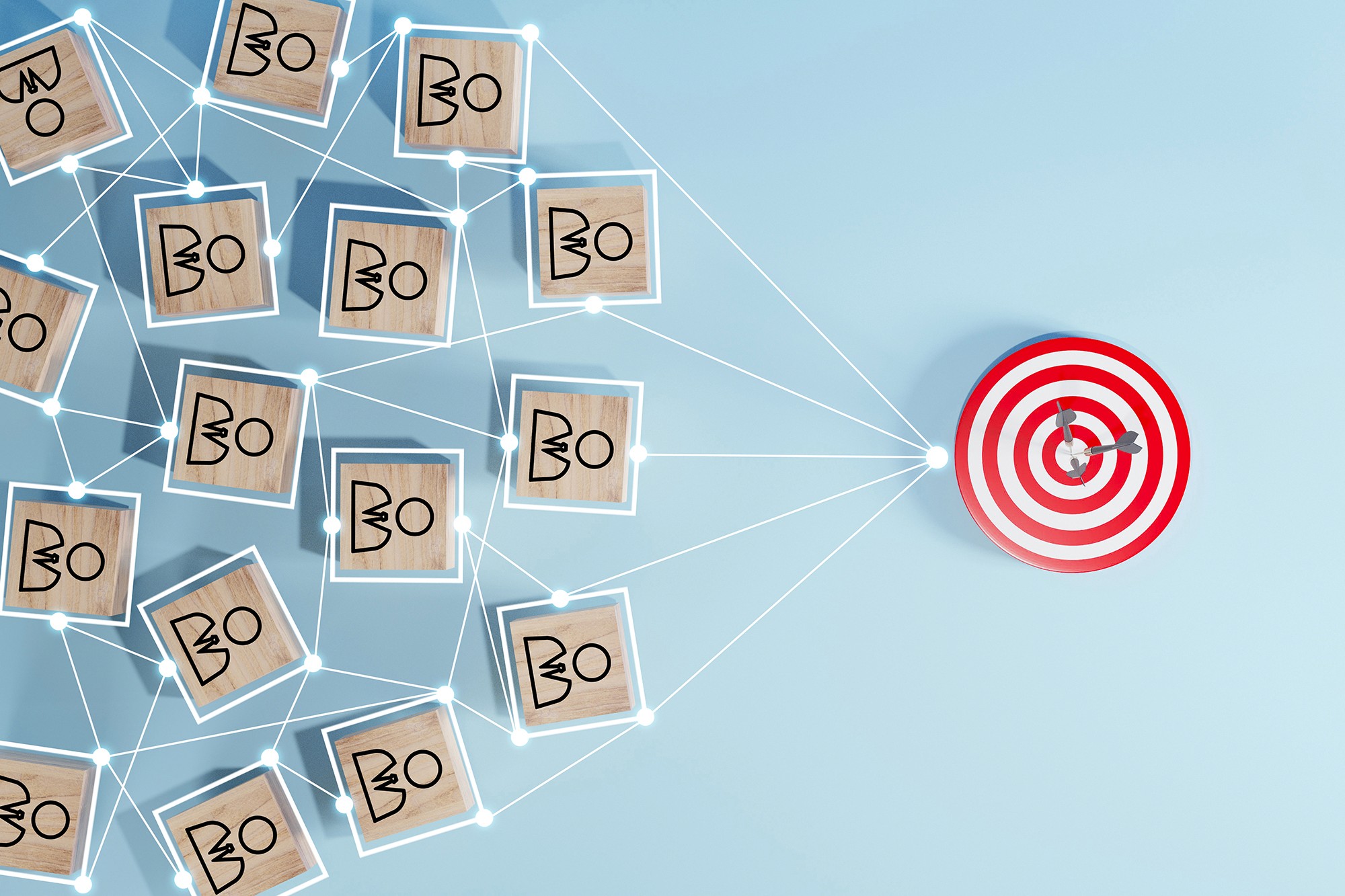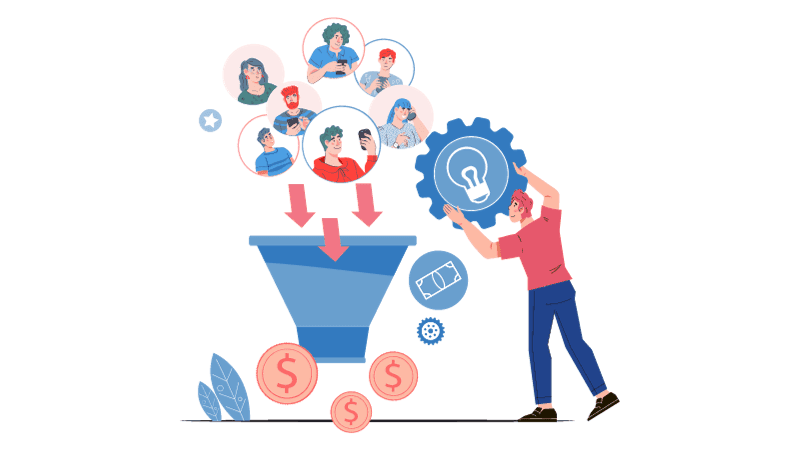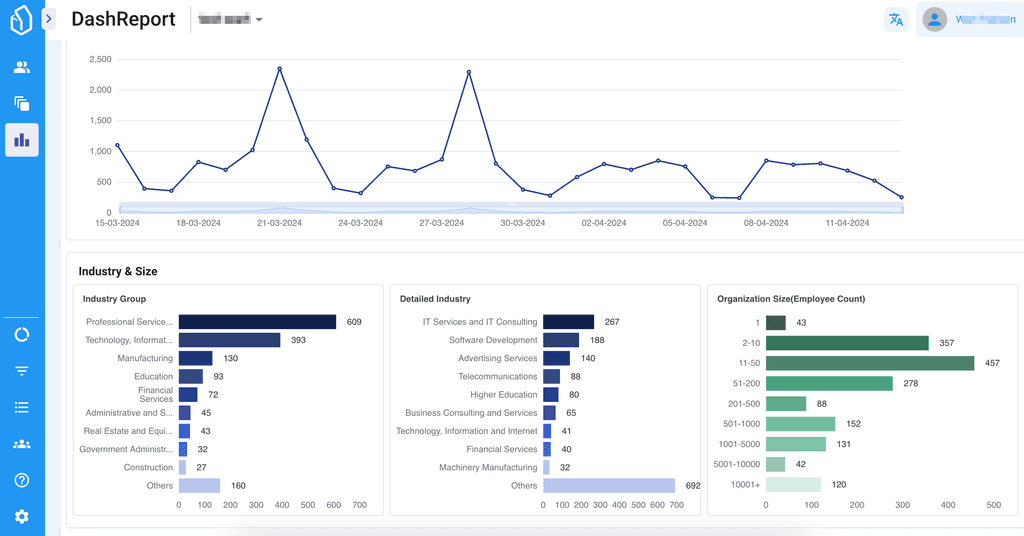
Lead Generation
Upcoming Trends in Lead Generation & Management for 2023
Upcoming Trends in Lead Generation & Management for 2023
2023-04-14

Lead Generation
Upcoming Trends in Lead Generation & Management for 2023
2023-04-14

Lead Generation
Upcoming Trends in Lead Generation & Management for 2023
2023-04-14
B2B lead generation services are an essential element of any successful marketing and sales strategy for 2023. Lead generation is the first step in creating a full sales pipeline. Along with lead qualification, lead management is an important tactic to use as customers begin their sales journey.
Understanding the upcoming trends across the B2B industry can help your team plan for future success. Lead generation is a proven methodology that has doubled in popularity since 2017.
To get started with your lead generation strategy, keep reading, or use the links below to “jump ahead”:
B2B lead generation services are an essential element of any successful marketing and sales strategy for 2023. Lead generation is the first step in creating a full sales pipeline. Along with lead qualification, lead management is an important tactic to use as customers begin their sales journey.
Understanding the upcoming trends across the B2B industry can help your team plan for future success. Lead generation is a proven methodology that has doubled in popularity since 2017.
To get started with your lead generation strategy, keep reading, or use the links below to “jump ahead”:
B2B lead generation services are an essential element of any successful marketing and sales strategy for 2023. Lead generation is the first step in creating a full sales pipeline. Along with lead qualification, lead management is an important tactic to use as customers begin their sales journey.
Understanding the upcoming trends across the B2B industry can help your team plan for future success. Lead generation is a proven methodology that has doubled in popularity since 2017.
To get started with your lead generation strategy, keep reading, or use the links below to “jump ahead”:
B2B lead generation services are an essential element of any successful marketing and sales strategy for 2023. Lead generation is the first step in creating a full sales pipeline. Along with lead qualification, lead management is an important tactic to use as customers begin their sales journey.
Understanding the upcoming trends across the B2B industry can help your team plan for future success. Lead generation is a proven methodology that has doubled in popularity since 2017.
To get started with your lead generation strategy, keep reading, or use the links below to “jump ahead”:
Table of Contents
Auto Generated TOC
Auto Generated TOC
Auto Generated TOC
Auto Generated TOC
What Is a Lead Generation Strategy?

Simply put, lead generation is the process of finding prospects who may be interested in your product and adding them to your sales pipeline. These potential clients should be qualified and scored based on their readiness to make a purchase. Then, they will be handed over to either marketing or sales to continue their customer journey.
Creating a lead generation strategy will help your marketing and sales team plan out where their energy should be used. This strategy will help uncover new leads as well as re-engage those who may have fallen out of the pipeline.
More than half of all marketers are spending at least 50% of their budget on generating leads, yet only 80% of marketers rate their efforts as somewhat effective. Capitalizing and improving lead generation tactics can make a huge difference in return on investment (ROI) for marketing departments.
There are four main components of a lead generation strategy: lead capture, lead magnets, conversion techniques and lead scoring. Understanding all of these elements will help your company create a well-rounded strategy and take advantage of upcoming trends.
Lead Capture
Many buyers do their own research when looking for solutions for their businesses. There’s a good chance most start with a Google search and click through the web pages that pop up.
It takes at least three months for 63% of generated leads to convert.This means identifying, capturing and engaging website traffic is extremely important for filling your sales funnel with prospects ready to start their customer journey.
Capturing leads can be accomplished in a few ways, including contact information forms and the use of lead generation software. Software like LeadBoxer helps your team identify and score prospects based on their activity on your website. Using these tools can help your team gather contact information and interact with interested customers.
Lead Magnets
This component can help your team avoid losing touch with one-time visitors to your website. If your attempts to gather contact information are stalling, lead magnets are a great way to interact with the customer and begin establishing a relationship.
A lead magnet is a type of content that provides value information to online visitors in exchange for their contact information. Lead magnets can be as simple as a free trial or webinar. White papers or eBooks are also great lead magnet options.
Educational blogs see 52% more organic web traffic than blogs focused on company information. Search engine optimization (SEO) still matters, and prospects are interested in the value your content can provide. This type of marketing material may persuade website visitors to join your mailing list or schedule a sales call.
When a prospect goes to register or download your gated content, they will need to put in their contact information, which allows your team to easily add them to the sales pipeline.
Conversion Techniques
Using a lead generation landing page is another way to gather contact information from prospects. Utilizing this practice can help your team stay on top of the newest trends for 2023. Currently, just 68% of B2B companies use landing pages for lead generation.
These types of pages serve two purposes:
Adding customers to your pipeline while educating them about the services you can provide.
Combining landing pages with ads is a great way to direct web traffic to your site.
Lead Scoring
Before pushing your generated leads to the pipeline, it’s important to rank prospects based on how likely they are to convert. This will help manage your leads and make sure customers are receiving communication that fits their current stage in the buying journey.
According to Hubspot, 79% of B2B companies lack an established lead scoring system. Adopting this tactic can put your team ahead of the curve, ready and able to take advantage of current trends.
Lead Generation Trends for 2023
As the B2B industry continues its emergence out of the COVID-19 pandemic, some lasting effects can still be felt. In 2023, lead generation strategy will continue to remain fully digital.
According to McKinsey, the majority of decision makers for B2B companies prefer the digital landscape. Relying on automation can help companies stay competitive in the B2B industry.
Webinars and video content will continue to grow as key components of marketing for the B2B buyer in 2023. Insider Intelligence found that webinars about the product are attended by 55% of prospects before they accept a sales meeting,
Implementing a chat bot may be a way to get ahead of competitors. While it seems like a lot of websites have chat bots available, only 33% are used to create conversions with marketers.
Taking advantage of this opportunity can help funnel more interested prospects into your pipeline. Research predicts the use of chat bots will help facilitate $142 billion USD of consumer spending by 2024.
What Is Lead Management?

Lead management is the strategy your marketing team uses to capture, qualify and track leads before passing them along to your salespeople. It is crucial to organize this data. If your company isn’t focused on executing a strong lead management system, resources and efforts will go to waste, which can contribute to an overall lower ROI from marketing costs.
Inbound leads can lower costs per lead by 61%; outbound leads tend to cost 39% more. This means using lead generation strategies and creating a successful management plan can help lower overall costs for your organization.
A main component of successful lead management is automation. Investing in the right software can help your team reduce manual labor, maintain clean data and analyze leads in real time. 80% of marketers believe incorporating automation into their marketing efforts helps generate more leads, as well as conversions.
Using LeadBoxer as your lead generation and management platform can help you identify, qualify, score and manage leads in one place. It also includes integrations that work seamlessly with other software in your tech stack. This helps streamline communication between sales and marketing departments.
Leadboxer successfully helps with data cleansing by using profile enrichment to update customer information. The platform also provides marketing insights, which helps give automatic data analytics for your team to use.
LeadBoxer’s Custom Lead Scoring Tool works to make sure your sales team is concentrating on customers who are most likely to convert. This cutting edge software automatically calculates a lead score using a variety of factors to determine how each prospect should be ranked.
By integrating with your tech stack, Leadboxer works with Google, HubSpot, LinkedIn, Mailchimp, Marketo, Outlook, WordPress and others to ensure your data is clean and leads are properly qualified.
Using lead management and qualification can help your company stay ahead of the curve. For companies working without automation, verifying leads and deciding their value can be a difficult challenge.
Just 56% of B2B marketers verify a business and its information before sending the lead to sales. With Leadboxer’s platform, lead scoring is handled automatically, so marketing doesn’t have to worry about passing along bad leads.
The B2B Lead Generation Services Market
The B2B lead generation services market is trending upwards for 2023 and beyond. This data can help predict what to watch for in the coming years.
Experts predict the market will continue to benefit from technological innovation. With new advancements, products will continue to improve, which will increase usage across the industry.
The market is expected to expand to multi-millions by 2027. Reports show the 2021 market held a value of 1900.34 million USD, which is predicted to grow to 3733.52 million over the next four years.
Business Research Insights revealed challenges the industry may face in 2023 include a lack of awareness around its services. Smaller businesses need to discover the market so they can boost participation.
Get a jumpstart on your lead generation strategy for the new year, and see how LeadBoxer’s lead scoring feature can help your company with a free trial!
What Is a Lead Generation Strategy?

Simply put, lead generation is the process of finding prospects who may be interested in your product and adding them to your sales pipeline. These potential clients should be qualified and scored based on their readiness to make a purchase. Then, they will be handed over to either marketing or sales to continue their customer journey.
Creating a lead generation strategy will help your marketing and sales team plan out where their energy should be used. This strategy will help uncover new leads as well as re-engage those who may have fallen out of the pipeline.
More than half of all marketers are spending at least 50% of their budget on generating leads, yet only 80% of marketers rate their efforts as somewhat effective. Capitalizing and improving lead generation tactics can make a huge difference in return on investment (ROI) for marketing departments.
There are four main components of a lead generation strategy: lead capture, lead magnets, conversion techniques and lead scoring. Understanding all of these elements will help your company create a well-rounded strategy and take advantage of upcoming trends.
Lead Capture
Many buyers do their own research when looking for solutions for their businesses. There’s a good chance most start with a Google search and click through the web pages that pop up.
It takes at least three months for 63% of generated leads to convert.This means identifying, capturing and engaging website traffic is extremely important for filling your sales funnel with prospects ready to start their customer journey.
Capturing leads can be accomplished in a few ways, including contact information forms and the use of lead generation software. Software like LeadBoxer helps your team identify and score prospects based on their activity on your website. Using these tools can help your team gather contact information and interact with interested customers.
Lead Magnets
This component can help your team avoid losing touch with one-time visitors to your website. If your attempts to gather contact information are stalling, lead magnets are a great way to interact with the customer and begin establishing a relationship.
A lead magnet is a type of content that provides value information to online visitors in exchange for their contact information. Lead magnets can be as simple as a free trial or webinar. White papers or eBooks are also great lead magnet options.
Educational blogs see 52% more organic web traffic than blogs focused on company information. Search engine optimization (SEO) still matters, and prospects are interested in the value your content can provide. This type of marketing material may persuade website visitors to join your mailing list or schedule a sales call.
When a prospect goes to register or download your gated content, they will need to put in their contact information, which allows your team to easily add them to the sales pipeline.
Conversion Techniques
Using a lead generation landing page is another way to gather contact information from prospects. Utilizing this practice can help your team stay on top of the newest trends for 2023. Currently, just 68% of B2B companies use landing pages for lead generation.
These types of pages serve two purposes:
Adding customers to your pipeline while educating them about the services you can provide.
Combining landing pages with ads is a great way to direct web traffic to your site.
Lead Scoring
Before pushing your generated leads to the pipeline, it’s important to rank prospects based on how likely they are to convert. This will help manage your leads and make sure customers are receiving communication that fits their current stage in the buying journey.
According to Hubspot, 79% of B2B companies lack an established lead scoring system. Adopting this tactic can put your team ahead of the curve, ready and able to take advantage of current trends.
Lead Generation Trends for 2023
As the B2B industry continues its emergence out of the COVID-19 pandemic, some lasting effects can still be felt. In 2023, lead generation strategy will continue to remain fully digital.
According to McKinsey, the majority of decision makers for B2B companies prefer the digital landscape. Relying on automation can help companies stay competitive in the B2B industry.
Webinars and video content will continue to grow as key components of marketing for the B2B buyer in 2023. Insider Intelligence found that webinars about the product are attended by 55% of prospects before they accept a sales meeting,
Implementing a chat bot may be a way to get ahead of competitors. While it seems like a lot of websites have chat bots available, only 33% are used to create conversions with marketers.
Taking advantage of this opportunity can help funnel more interested prospects into your pipeline. Research predicts the use of chat bots will help facilitate $142 billion USD of consumer spending by 2024.
What Is Lead Management?

Lead management is the strategy your marketing team uses to capture, qualify and track leads before passing them along to your salespeople. It is crucial to organize this data. If your company isn’t focused on executing a strong lead management system, resources and efforts will go to waste, which can contribute to an overall lower ROI from marketing costs.
Inbound leads can lower costs per lead by 61%; outbound leads tend to cost 39% more. This means using lead generation strategies and creating a successful management plan can help lower overall costs for your organization.
A main component of successful lead management is automation. Investing in the right software can help your team reduce manual labor, maintain clean data and analyze leads in real time. 80% of marketers believe incorporating automation into their marketing efforts helps generate more leads, as well as conversions.
Using LeadBoxer as your lead generation and management platform can help you identify, qualify, score and manage leads in one place. It also includes integrations that work seamlessly with other software in your tech stack. This helps streamline communication between sales and marketing departments.
Leadboxer successfully helps with data cleansing by using profile enrichment to update customer information. The platform also provides marketing insights, which helps give automatic data analytics for your team to use.
LeadBoxer’s Custom Lead Scoring Tool works to make sure your sales team is concentrating on customers who are most likely to convert. This cutting edge software automatically calculates a lead score using a variety of factors to determine how each prospect should be ranked.
By integrating with your tech stack, Leadboxer works with Google, HubSpot, LinkedIn, Mailchimp, Marketo, Outlook, WordPress and others to ensure your data is clean and leads are properly qualified.
Using lead management and qualification can help your company stay ahead of the curve. For companies working without automation, verifying leads and deciding their value can be a difficult challenge.
Just 56% of B2B marketers verify a business and its information before sending the lead to sales. With Leadboxer’s platform, lead scoring is handled automatically, so marketing doesn’t have to worry about passing along bad leads.
The B2B Lead Generation Services Market
The B2B lead generation services market is trending upwards for 2023 and beyond. This data can help predict what to watch for in the coming years.
Experts predict the market will continue to benefit from technological innovation. With new advancements, products will continue to improve, which will increase usage across the industry.
The market is expected to expand to multi-millions by 2027. Reports show the 2021 market held a value of 1900.34 million USD, which is predicted to grow to 3733.52 million over the next four years.
Business Research Insights revealed challenges the industry may face in 2023 include a lack of awareness around its services. Smaller businesses need to discover the market so they can boost participation.
Get a jumpstart on your lead generation strategy for the new year, and see how LeadBoxer’s lead scoring feature can help your company with a free trial!
What Is a Lead Generation Strategy?

Simply put, lead generation is the process of finding prospects who may be interested in your product and adding them to your sales pipeline. These potential clients should be qualified and scored based on their readiness to make a purchase. Then, they will be handed over to either marketing or sales to continue their customer journey.
Creating a lead generation strategy will help your marketing and sales team plan out where their energy should be used. This strategy will help uncover new leads as well as re-engage those who may have fallen out of the pipeline.
More than half of all marketers are spending at least 50% of their budget on generating leads, yet only 80% of marketers rate their efforts as somewhat effective. Capitalizing and improving lead generation tactics can make a huge difference in return on investment (ROI) for marketing departments.
There are four main components of a lead generation strategy: lead capture, lead magnets, conversion techniques and lead scoring. Understanding all of these elements will help your company create a well-rounded strategy and take advantage of upcoming trends.
Lead Capture
Many buyers do their own research when looking for solutions for their businesses. There’s a good chance most start with a Google search and click through the web pages that pop up.
It takes at least three months for 63% of generated leads to convert.This means identifying, capturing and engaging website traffic is extremely important for filling your sales funnel with prospects ready to start their customer journey.
Capturing leads can be accomplished in a few ways, including contact information forms and the use of lead generation software. Software like LeadBoxer helps your team identify and score prospects based on their activity on your website. Using these tools can help your team gather contact information and interact with interested customers.
Lead Magnets
This component can help your team avoid losing touch with one-time visitors to your website. If your attempts to gather contact information are stalling, lead magnets are a great way to interact with the customer and begin establishing a relationship.
A lead magnet is a type of content that provides value information to online visitors in exchange for their contact information. Lead magnets can be as simple as a free trial or webinar. White papers or eBooks are also great lead magnet options.
Educational blogs see 52% more organic web traffic than blogs focused on company information. Search engine optimization (SEO) still matters, and prospects are interested in the value your content can provide. This type of marketing material may persuade website visitors to join your mailing list or schedule a sales call.
When a prospect goes to register or download your gated content, they will need to put in their contact information, which allows your team to easily add them to the sales pipeline.
Conversion Techniques
Using a lead generation landing page is another way to gather contact information from prospects. Utilizing this practice can help your team stay on top of the newest trends for 2023. Currently, just 68% of B2B companies use landing pages for lead generation.
These types of pages serve two purposes:
Adding customers to your pipeline while educating them about the services you can provide.
Combining landing pages with ads is a great way to direct web traffic to your site.
Lead Scoring
Before pushing your generated leads to the pipeline, it’s important to rank prospects based on how likely they are to convert. This will help manage your leads and make sure customers are receiving communication that fits their current stage in the buying journey.
According to Hubspot, 79% of B2B companies lack an established lead scoring system. Adopting this tactic can put your team ahead of the curve, ready and able to take advantage of current trends.
Lead Generation Trends for 2023
As the B2B industry continues its emergence out of the COVID-19 pandemic, some lasting effects can still be felt. In 2023, lead generation strategy will continue to remain fully digital.
According to McKinsey, the majority of decision makers for B2B companies prefer the digital landscape. Relying on automation can help companies stay competitive in the B2B industry.
Webinars and video content will continue to grow as key components of marketing for the B2B buyer in 2023. Insider Intelligence found that webinars about the product are attended by 55% of prospects before they accept a sales meeting,
Implementing a chat bot may be a way to get ahead of competitors. While it seems like a lot of websites have chat bots available, only 33% are used to create conversions with marketers.
Taking advantage of this opportunity can help funnel more interested prospects into your pipeline. Research predicts the use of chat bots will help facilitate $142 billion USD of consumer spending by 2024.
What Is Lead Management?

Lead management is the strategy your marketing team uses to capture, qualify and track leads before passing them along to your salespeople. It is crucial to organize this data. If your company isn’t focused on executing a strong lead management system, resources and efforts will go to waste, which can contribute to an overall lower ROI from marketing costs.
Inbound leads can lower costs per lead by 61%; outbound leads tend to cost 39% more. This means using lead generation strategies and creating a successful management plan can help lower overall costs for your organization.
A main component of successful lead management is automation. Investing in the right software can help your team reduce manual labor, maintain clean data and analyze leads in real time. 80% of marketers believe incorporating automation into their marketing efforts helps generate more leads, as well as conversions.
Using LeadBoxer as your lead generation and management platform can help you identify, qualify, score and manage leads in one place. It also includes integrations that work seamlessly with other software in your tech stack. This helps streamline communication between sales and marketing departments.
Leadboxer successfully helps with data cleansing by using profile enrichment to update customer information. The platform also provides marketing insights, which helps give automatic data analytics for your team to use.
LeadBoxer’s Custom Lead Scoring Tool works to make sure your sales team is concentrating on customers who are most likely to convert. This cutting edge software automatically calculates a lead score using a variety of factors to determine how each prospect should be ranked.
By integrating with your tech stack, Leadboxer works with Google, HubSpot, LinkedIn, Mailchimp, Marketo, Outlook, WordPress and others to ensure your data is clean and leads are properly qualified.
Using lead management and qualification can help your company stay ahead of the curve. For companies working without automation, verifying leads and deciding their value can be a difficult challenge.
Just 56% of B2B marketers verify a business and its information before sending the lead to sales. With Leadboxer’s platform, lead scoring is handled automatically, so marketing doesn’t have to worry about passing along bad leads.
The B2B Lead Generation Services Market
The B2B lead generation services market is trending upwards for 2023 and beyond. This data can help predict what to watch for in the coming years.
Experts predict the market will continue to benefit from technological innovation. With new advancements, products will continue to improve, which will increase usage across the industry.
The market is expected to expand to multi-millions by 2027. Reports show the 2021 market held a value of 1900.34 million USD, which is predicted to grow to 3733.52 million over the next four years.
Business Research Insights revealed challenges the industry may face in 2023 include a lack of awareness around its services. Smaller businesses need to discover the market so they can boost participation.
Get a jumpstart on your lead generation strategy for the new year, and see how LeadBoxer’s lead scoring feature can help your company with a free trial!
What Is a Lead Generation Strategy?

Simply put, lead generation is the process of finding prospects who may be interested in your product and adding them to your sales pipeline. These potential clients should be qualified and scored based on their readiness to make a purchase. Then, they will be handed over to either marketing or sales to continue their customer journey.
Creating a lead generation strategy will help your marketing and sales team plan out where their energy should be used. This strategy will help uncover new leads as well as re-engage those who may have fallen out of the pipeline.
More than half of all marketers are spending at least 50% of their budget on generating leads, yet only 80% of marketers rate their efforts as somewhat effective. Capitalizing and improving lead generation tactics can make a huge difference in return on investment (ROI) for marketing departments.
There are four main components of a lead generation strategy: lead capture, lead magnets, conversion techniques and lead scoring. Understanding all of these elements will help your company create a well-rounded strategy and take advantage of upcoming trends.
Lead Capture
Many buyers do their own research when looking for solutions for their businesses. There’s a good chance most start with a Google search and click through the web pages that pop up.
It takes at least three months for 63% of generated leads to convert.This means identifying, capturing and engaging website traffic is extremely important for filling your sales funnel with prospects ready to start their customer journey.
Capturing leads can be accomplished in a few ways, including contact information forms and the use of lead generation software. Software like LeadBoxer helps your team identify and score prospects based on their activity on your website. Using these tools can help your team gather contact information and interact with interested customers.
Lead Magnets
This component can help your team avoid losing touch with one-time visitors to your website. If your attempts to gather contact information are stalling, lead magnets are a great way to interact with the customer and begin establishing a relationship.
A lead magnet is a type of content that provides value information to online visitors in exchange for their contact information. Lead magnets can be as simple as a free trial or webinar. White papers or eBooks are also great lead magnet options.
Educational blogs see 52% more organic web traffic than blogs focused on company information. Search engine optimization (SEO) still matters, and prospects are interested in the value your content can provide. This type of marketing material may persuade website visitors to join your mailing list or schedule a sales call.
When a prospect goes to register or download your gated content, they will need to put in their contact information, which allows your team to easily add them to the sales pipeline.
Conversion Techniques
Using a lead generation landing page is another way to gather contact information from prospects. Utilizing this practice can help your team stay on top of the newest trends for 2023. Currently, just 68% of B2B companies use landing pages for lead generation.
These types of pages serve two purposes:
Adding customers to your pipeline while educating them about the services you can provide.
Combining landing pages with ads is a great way to direct web traffic to your site.
Lead Scoring
Before pushing your generated leads to the pipeline, it’s important to rank prospects based on how likely they are to convert. This will help manage your leads and make sure customers are receiving communication that fits their current stage in the buying journey.
According to Hubspot, 79% of B2B companies lack an established lead scoring system. Adopting this tactic can put your team ahead of the curve, ready and able to take advantage of current trends.
Lead Generation Trends for 2023
As the B2B industry continues its emergence out of the COVID-19 pandemic, some lasting effects can still be felt. In 2023, lead generation strategy will continue to remain fully digital.
According to McKinsey, the majority of decision makers for B2B companies prefer the digital landscape. Relying on automation can help companies stay competitive in the B2B industry.
Webinars and video content will continue to grow as key components of marketing for the B2B buyer in 2023. Insider Intelligence found that webinars about the product are attended by 55% of prospects before they accept a sales meeting,
Implementing a chat bot may be a way to get ahead of competitors. While it seems like a lot of websites have chat bots available, only 33% are used to create conversions with marketers.
Taking advantage of this opportunity can help funnel more interested prospects into your pipeline. Research predicts the use of chat bots will help facilitate $142 billion USD of consumer spending by 2024.
What Is Lead Management?

Lead management is the strategy your marketing team uses to capture, qualify and track leads before passing them along to your salespeople. It is crucial to organize this data. If your company isn’t focused on executing a strong lead management system, resources and efforts will go to waste, which can contribute to an overall lower ROI from marketing costs.
Inbound leads can lower costs per lead by 61%; outbound leads tend to cost 39% more. This means using lead generation strategies and creating a successful management plan can help lower overall costs for your organization.
A main component of successful lead management is automation. Investing in the right software can help your team reduce manual labor, maintain clean data and analyze leads in real time. 80% of marketers believe incorporating automation into their marketing efforts helps generate more leads, as well as conversions.
Using LeadBoxer as your lead generation and management platform can help you identify, qualify, score and manage leads in one place. It also includes integrations that work seamlessly with other software in your tech stack. This helps streamline communication between sales and marketing departments.
Leadboxer successfully helps with data cleansing by using profile enrichment to update customer information. The platform also provides marketing insights, which helps give automatic data analytics for your team to use.
LeadBoxer’s Custom Lead Scoring Tool works to make sure your sales team is concentrating on customers who are most likely to convert. This cutting edge software automatically calculates a lead score using a variety of factors to determine how each prospect should be ranked.
By integrating with your tech stack, Leadboxer works with Google, HubSpot, LinkedIn, Mailchimp, Marketo, Outlook, WordPress and others to ensure your data is clean and leads are properly qualified.
Using lead management and qualification can help your company stay ahead of the curve. For companies working without automation, verifying leads and deciding their value can be a difficult challenge.
Just 56% of B2B marketers verify a business and its information before sending the lead to sales. With Leadboxer’s platform, lead scoring is handled automatically, so marketing doesn’t have to worry about passing along bad leads.
The B2B Lead Generation Services Market
The B2B lead generation services market is trending upwards for 2023 and beyond. This data can help predict what to watch for in the coming years.
Experts predict the market will continue to benefit from technological innovation. With new advancements, products will continue to improve, which will increase usage across the industry.
The market is expected to expand to multi-millions by 2027. Reports show the 2021 market held a value of 1900.34 million USD, which is predicted to grow to 3733.52 million over the next four years.
Business Research Insights revealed challenges the industry may face in 2023 include a lack of awareness around its services. Smaller businesses need to discover the market so they can boost participation.
Get a jumpstart on your lead generation strategy for the new year, and see how LeadBoxer’s lead scoring feature can help your company with a free trial!

Generate More Qualified Leads with LeadBoxer
Create a (free) account or get a demo and find out how we can help you.

Generate More Qualified Leads with LeadBoxer
Create a (free) account or get a demo and find out how we can help you.

Generate More Qualified Leads with LeadBoxer
Create a (free) account or get a demo and find out how we can help you.

Generate More Qualified Leads with LeadBoxer
Create a (free) account or get a demo and find out how we can help you.
Get Started with LeadBoxer
LeadBoxer can help you quickly generate more leads
Get more insight into your online audience and their behaviour, and turn this data into actual opportunities.
Start Now!
Get Started with LeadBoxer
LeadBoxer can help you quickly generate more leads
Get more insight into your online audience and their behaviour, and turn this data into actual opportunities.
Start Now!
Get Started with LeadBoxer
LeadBoxer can help you quickly generate more leads
Get more insight into your online audience and their behaviour, and turn this data into actual opportunities.
Start Now!
Get Started with LeadBoxer
LeadBoxer can help you quickly generate more leads
Get more insight into your online audience and their behaviour, and turn this data into actual opportunities.
Start Now!
Other content in category
Lead Generation



Improved Lead Targeting Through Data-Driven Segmentation



Digital Lead Investing: Definition, Myths, Steps, and Strategies



5 Steps To Start Local Lead Generation For Your Business



How Do You Develop an Effective Content Distribution Strategy



What is Lead Enrichment?

Supercharge your marketing results with LeadBoxer!
Analyze campaigns and traffic, segement by industry, drilldown on company size and filter by location. See your Top pages, top accounts, and many other metrics.


Supercharge your marketing results with LeadBoxer!
Analyze campaigns and traffic, segement by industry, drilldown on company size and filter by location. See your Top pages, top accounts, and many other metrics.


Supercharge your marketing results with LeadBoxer!
Analyze campaigns and traffic, segement by industry, drilldown on company size and filter by location. See your Top pages, top accounts, and many other metrics.


Supercharge your marketing results with LeadBoxer!
Analyze campaigns and traffic, segement by industry, drilldown on company size and filter by location. See your Top pages, top accounts, and many other metrics.


